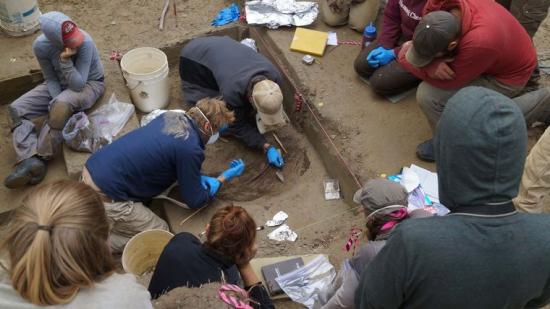Theresa Bakker
Source - http://www.newsminer.com/features/sundays/community_features/how-humans-survived-the-last-ice-age/article_8329b3a2-e617-11e4-b63e-77ed8b35815f.html

Ben Potter and Josh Reuther excavate the pit feature at the Upward Sun River archaeological site. Photo courtesy of Ben Potter
Alaska looked very different during the last glacial period. At the end of the Pleistocene, also known as the Ice Age, thick ice sheets buried most of northern North America and Canada from between 100,000 to 12,000 years ago. But Interior Alaska, connected to Asia via the Bering Land Bridge known as Beringia, remained beyond the glacier’s edge fostering an immense grassland and a diverse community of grazing mammals.
The region was populated with now-extinct short-faced bears, saber tooth cats, American lions, steppe bison, mastodons and mammoths. Sharing the land were other animals that still flourish in the area today, such as Dall sheep, brown bears, caribou, muskox, wolves and wolverines.
Another feature of the Ice Age that survived a changing climate was humans. New data are helping us understand their transition from the Ice Age to a modern climate.
Ben Potter is an associate anthropology professor at the University of Alaska Fairbanks. He and archaeology curator Josh Reuther will talk about climate change and human land use in Ice Age Alaska during a Museum Discovery Series presentation 6 p.m. Thursday.
By the time people first crossed Beringia, Potter said the landscape was already changing, with periods of cold and dry followed by warm and wetter conditions. During this deglaciation process, people were able to cope with ecological stress while preserving their basic way of life.
Potter said the peopling of Alaska is part of a remarkable story of the earliest expansions into far Northeast Asia and eventually the New World, the last major continent to be colonized by humans. Research shows that as the earliest North American colonizers encountered a wide suite of animals, they seemed to focus their hunting efforts on bison and elk.
“Bison hunting seems to extend many thousands of years after the last Ice Age,” he said. “That paints a picture of conservatism in technology and resiliency in subsistence economies. Waterfowl, fish and small mammals likely also played an important role in paleo-diets. We’re tracking varying emphasis on different types of animals using a wide variety of methods and datasets.”
One of the most interesting pieces of evidence in the effort to understand the lifestyles of these Ice Age Alaskans was discovered in 2010 during excavations at an archaeological site north of the Tanana River. Potter and other archaeologists uncovered the partially cremated remains of a three-year-old in the hearth of a subterranean house built 11,500 years ago.
The Upward Sun River site was likely occupied by the Denali people who inhabited central Alaska from 12,000 to 6,000 years ago. Potter says the discovery is remarkable in many ways. “The presence of human remains can provide direct evidence on diet and movement on the landscape.”
For instance, the scientists found well-preserved animal remains. And instead of a short-term hunting camp, which many archaeological sites of this age tend to be, Upward Sun River is a base camp where people were engaged in a variety of behaviors, including activities associated with women and children.
Working along with local tribal groups, the archaeologists, including curator Reuther, expanded the excavation in 2013. They found another remarkable burial site with two children laid side by side: an infant who died at least six weeks after birth and a fetus, possibly stillborn.
Reuther said the care shown was immense. “This is the earliest multiple burial we have recorded in North America and one of the earliest with grave goods.”
Three ivory foreshafts marked with x’s and featuring projectile points attached to their tops were placed alongside the children, some of the earliest decorated artifacts ever found in northern North America. These discoveries could lead to new thinking about how early societies were structured, how they treated the youngest members of their society and even how they viewed death.
“Human adaptations during the last Ice Age are important because the landscape and climate in high latitudes like Alaska were so fundamentally different than today,” Potter said. “Considering how humans coped with climate change that was even more radical than what we are seeing today can help us understand the complex interrelationships among plants, animals and those that depend on them.”
That will take a multi-layered approach. Reuther said projects such as Upward Sun River include several UAF researchers from different backgrounds working together to understand how humans coped in changing environments.
“At UAF, we have a wealth of researchers with diverse backgrounds, interests and specialties, along with institutions like the museum which are fundamentally multi-disciplinary in nature. This allows for a collaborative project that can help us understand how humans coped in changing climates and environments.”